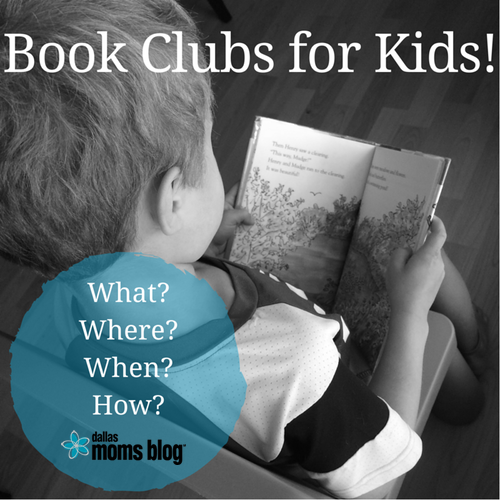One of my favorite nights of the month is definitely our neighborhood book club — Krystal has written about hers in the past. If you love to read and aren’t a member of a book club, I highly recommend it. In fact, I found out recently that book clubs don’t just have to be for adults. You can help foster a love of reading and encourage critical thinking in elementary aged kids by starting a kids book club!
I learned about kids book clubs from a few ladies at my own book club who have children slightly older than my own (mine are currently 4 and 5 years old). It’s really good timing because my son is going to kindergarten this year and that would be the earliest you could probably start with a book club, per Lindsay Stenbergl (book club mom and friend!), Lower School Literacy and Learning Support Specialist at Greenhill School in Dallas.
Per Lindsay, here are a few things to consider when starting a kids book club:
- levels of the readers
- will the parents going be reading with the kids? If they are, you can go to a little bit higher reading level
- how often you want to meet
- kids need activities and concrete activities to help them process the book… or if it’s a discussion, don’t expect it to be too focused for too long
I became particularly interested in this idea because one of the kids book clubs in our neighborhood this past year chose books that fostered empathy and compassion. After the rough year our country has had with so much violence in the news in the past year, I thought this seemed appropriate. Developing positive traits in our children now is so important to prevent bullying and encourage diversity in friendships and in later life. Examples of books like this include: The One and Only Ivan by Katherine Applegate and Wonder by R.J. Palacio
Another angle you might take with older children is one of your own favorite series of books. I know a mom who started a Harry Potter book club in the upper elementary/middle school age group. There are so many ways you can bring great social and moral discussions into a series like that! Other series that you might feel nostalgia for could be: The Chronicles of Narnia, Anne of Green Gables, or even the American Girl series of books. Lindsay’s group of kindergarten girls read books by Kevin Henkes. They aren’t a series, but they have common themes.
The details: when, where, and how often? Make the list of children (and parents) who are interested and base these details around their needs. Lindsay mentioned that for their first meeting she took the girls into one room to show them the books they’d be reading and another mom took the moms into another room to talk scheduling, so that they got all the future meetings scheduled all at once. Often it’s best to meet only once a month so that there is plenty of time to read the book, but not so long that it’s been forgotten. For shorter books or younger children, you might meet every 2 weeks. Start a conversation with the parents first regarding scheduling. Do try to keep it small — it’s difficult to organize schedules with a group as large as 15 children. After school is great during the year, but you can do later in the evening and incorporate dinner or dessert after the discussion if that’s more convenient. Sometimes there might be a fun food theme to match the book!
Finally, consider the timing. If you are thinking of starting at the kindergarten level, Lindsay recommended waiting until the very end of the school year or even summer, because kindergarteners tend to be overwhelmed by school at first. Give them a little breathing room. However, many schools like ours have a summer reading list, so if you are starting with younger children, you might actually delay this idea until summer and use that summer reading list for book club. Alternatively, if you have older children that struggle with being interested during the school year, during the semester might be helpful.
The goal of a kids book club is to make reading fun and interactive, and to get kids to process what they read. It can look many different ways, just like the kids involved. Have fun, and let us know if you’ve tried this or plan to! What has worked for you?














